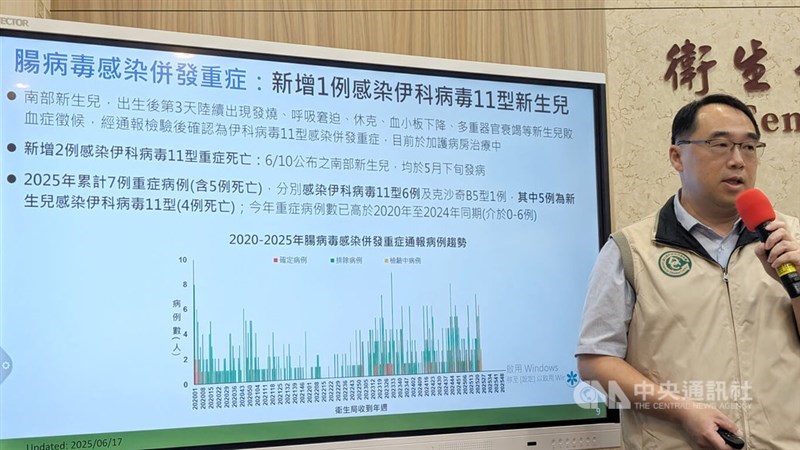
Taipei, June 17 (CNA) Two newborns died from enterovirus complications last week, and one new severe case was reported, the Taiwan Centers for Disease Control (CDC) said Tuesday.
One of the deaths, a baby girl who developed symptoms at 6 days old, suffered complications of fulminant hepatitis, septic shock and multiple organ failure, said CDC physician Lin Yung-ching (林詠青) at a press conference.
The other, a baby boy, showed symptoms at 3 days and died from septic shock, meningitis and multiple organ failure, Lin said.
Both were infected with the enteric cytopathic human orphan virus 11 (Echo 11).
The severe case, also involving Echo 11, is an infant boy who is currently in intensive care with his condition still unstable, Lin said.
A total of seven severe infant enterovirus cases have been recorded in 2025, a six-year high, according to CDC Spokesman Lo Yi-chun (羅一鈞).
Of the seven, five have died.
Four deaths and one severe case can be attributed to the Echo 11 strain, while the remaining death was caused by the Coxsackie B5, Lo said.
Based on past experience, the epidemic period for infant enterovirus is expected to last until the end of July, Lo said, urging expectant parents and newborn care institutions to remain vigilant.
Meanwhile, 6,009 people sought treatment for enterovirus last week, marking a 14 percent increase from 5,257 the previous week, showing that the overall spread has not reached epidemic level, said CDC Epidemic Intelligence Center Director Kuo Hung-wei (郭宏偉).
The predominant strain is Echo 11, accounting for 34 percent of cases, followed by Coxsackie A6 at 22 percent and Coxsackie A2 at 12 percent, Kuo said.
(By Tseng Yi-ning and Wu Kuan-hsien)
Enditem/AW
- Society
Heavy rain causes traffic disruptions in central, southern Taiwan
08/03/2025 09:44 PM - Society
- Sports
Giants suffer 6-12 loss in Teng Kai-wei's starter debut
08/03/2025 08:32 PM - Business
New U.S. tariffs on Philippines may deter Taiwanese investors
08/03/2025 07:46 PM - Sports
Taiwan loses to S. Korea in U-12 Baseball World Cup third-place game
08/03/2025 07:04 PM